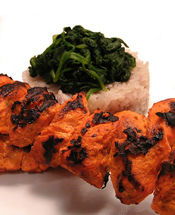Restaurants in Delhi
 People of Delhi take their food seriously and love to eat. There are dining options on every street, some small with mid-range prices and some expensive. While Chinese, Thai, Italian and Japanese are most popular, you can also find Lebanese, Mexican and Mediterranean restaurants in Delhi.
People of Delhi take their food seriously and love to eat. There are dining options on every street, some small with mid-range prices and some expensive. While Chinese, Thai, Italian and Japanese are most popular, you can also find Lebanese, Mexican and Mediterranean restaurants in Delhi.There are plenty of vegetarian choices as well, and vegan selections make common appearances on menus in the city. That being said, chicken and mutton are the meats most often used for cooking, while pork is served only in some establishments.
Some expats may be surprised to find that beef cannot be sold legally in Delhi, and can only be served with the appropriate licences. It follows that beef dishes are largely restricted to five star hotels. If beef dishes are offered in other restaurants, it would likely be buffalo, rather than cow meat that is used.
If you're a newly arrived expat to Delhi, then it would be better for you stick to bottled water and the larger, more mainstream restaurants. These do tend to be more expensive, but they will also be more hygienic and a safer option until your body adjusts to the local conditions.
Once you get rid of the fabled "Delhi Belly" and you're stomach develops a bit of the steel lining that Indians pride themselves on, you can even start enjoying the street food and hole-in-the-wall kebab eateries; some of Delhi's most precious hidden gems.
For up-to-date reviews and comprehensive contact details expats can check out either the Hindustan Times or the Times of India. Both newspapers release annual top 10 rankings, and put together print publications as well. Otherwise, magazines, like Burrp and Time Out also review a smaller selection of restaurants in each issue.
Recommended Indian restaurants in Delhi
[Frontier Food] BukharaA favourite of the Clinton's, and a multiple award winning restaurant that has dishes named in honour of the famous presidential couple. Arguably the most famous Indian eatery, it is ranked among the top 50 restaurants in the world and it serves delicious Northwest Frontier Province cuisine.
Tel: 2611 2233
[Mughlai] Karims
Karims' cooks are rumoured to be descendants of the royal cooks of past, and many of the recipes used are hundreds of years old. While there are many outlets spread across the
city, the best is undoubtedly the original - located in the picturesque Chandni Chowk area. This is the place to go if you are craving authentic kebabs.
www.karimhoteldelhi.com
Tel: 2326 9880, 2326 4981
 [Punjabi] Moti Mahal
[Punjabi] Moti MahalMoti Mahal claims that its originator, invented the famous "butter
chicken". While the bold statement can't be authenticated, their version of the dish is excellent and can be enjoyed with hot rotis and Makhani Dal. There are many branches in the city, expats should be sure to choose Moti Mahal, and not the Moti Mahal Deluxe chain.
Tel: 2327 3011
[Punjabi] Punjabi By Nature
The first restaurant to experiment with Indian flavours, try their drunken
prawns, tandoori quail and vodka golguppas.
www.punjabibynature.in
4151 6666, 4151 6668
[South Indian Vegetarian] Sagar Ratna
This is the place for excellent crispy dosas, hot idlis and sambhar and a host of other vegetarian dishes popularly known as Udupi cuisine. Sagar Ratna also serves some North Indian vegetarian dishes like Chole Bhatura and Rajma Chawal. They also have multiple locations across the city and NCR.
www.sagarratna.in
Tel: 2433 3688
[Indian Fusion] Indian Accent
The chef here does some innovative takes on Indian food using local and seasonal organic ingredients. There's a wonderful Chef's Menu if you want to taste the highlights; a wine pairing option exists as well.
www.themanordelhi.com
Tel: 4323 5151
[Kashmiri] Chor Bizarre
While Chor Bizarre does serve food from across the Northern region, the best option on the menu is the Kashmiri Wazwan cooked by chefs from Kashmir. Both vegetarian and non vegetarian options are available. The a la carte is much better than the buffet.
www.chorbizarrerestaurant.com
Tel: 4366 3600
[Bengali] Oh Calcutta
Bengali food focuses on fish and seafood, so it can be a welcome respite from the chicken and mutton heavy menus found in the rest of the city. Their lunch buffet is excellent value for money.
Tel: 2646 4180
[Gujarathi & Rajasthani] Rajdhani
A Bombay institution that has opened in Delhi and Gurgaon. They serve only unlimited vegetarian thalis. There is no menu, whatever they cook that day is what you get. The range is huge and the servers will keep feeding you until you are about to burst. Be sure to save space for dessert.
www.rajdhani.co.in
Tel: 4374 5577, 4109 6346
[Kerala] Gunpowder
This small eatery requires hungry patrons climb four flights of stairs, but the excellent Kerala food on offer is well-worth the trek. The fare is spicy, but the waiters can guide you towards less potent preparations and the appams and parathas are outstanding. Call for reservations before making the journey.
Tel: 2653 5700
[Anglo Indian] Brown Sahib
When the British were in India, a unique kind of cuisine was born. British staples recreated with Indian ingredients and Indian staples adapted for British palates. Brown Sahib is one of the very few restaurants in the country where you will get to taste this cuisine. They also offer Bengali food.
www.brownsahib.in
Tel: 4082 0027, 4082 0030
[North Indian] The Great Kebab Factory
You have a choice of vegetarian and non vegetarian. The menu for the day will have a limited variety of kebabs but in unlimited quantities. Excellent kebabs. Stick to the kebabs and breads, although the price also includes biryani and dhal. Multiple outlets in Delhi and NCR
www.thegreatkababfactory.com
Tel: 2677 9067
Recommended International restaurants in Delhi
[Japanese] AiAi serves excellent Japanese food including sushi flown in fresh daily. They
have three seating areas. The restaurant, the open air terrace and the lounge
area.
Tel: 4065 4567

[Thai] Ego Thai
The waiters are extremely helpful and will accommodate most requests to
eliminate or change certain ingredients. A lounge cum restaurant
spread across two floors, it offers excellent soups and Thai curries.
Tel: 2633 1181
[Chinese] The China Kitchen
Chinese was one of the first international cuisines that was available in India because Chinese traders came across and settled; opening shoe shops and restaurants along the way. A few years back, what passed as Chinese would actually be Indianised versions of Chinese dishes (called Indian Chinese), but some recent restaurants like The China Kitchen are doing excellent business, serving authentic Chinese Cuisine.
delhi.regency.hyatt.com
Tel: 6677 1334
[Italian] Diva
Chef Ritu Dalmia is well known for her passion for Italian food and she sources a lot of her ingredients from Italy itself. There are some unique pastas other than the standard white and red sauce options.
www.diva-italian.com
Tel: 2921 5673
[Greek] Its Greek to Me
One of the first authentic Greek restaurants to open in India it is heavily frequented by the expat crowd.
Tel: 4101 2240
[Middle Eastern] Shalom
All the standard favourites from the Lebanese and other Levantine and Middle Eastern menus can be found at this eatery.
www.shalomexperience.com
Tel: 4163 2280
[European] Smoke House Grill
They change their menu regularly and have some excellent dishes on offer. There's even a charcuterie on the premises if you want to pick up sandwich stuffers. Their Smoke House Deli in DLF Place in Vasant Kunj is also excellent and has an outdoor seating arrangement too.
Tel: 4143 5530
[Mexican] Rodeo
While expats will find many a familiar Mexican dish on this menu, they may not taste exactly like their original inspirations. Still, the food is quite good.
Tel: 2371 3870
[Café]The Big Chill Café
One of my favourite eat out locations in Delhi. They have two outlets in Khan Market and one at DLF Place in Saket. The décor is Hollywood posters and the food is excellent - from the home made ice cream based milk shakes and malts to their humongous dessert servings. Salads, sandwiches, pasta, grilled meat, pizzas, you can find it all here. Definitely try their baked potatoes with toppings.
Tel: 4175 7533
[American] All American Diner
They serve breakfast all day - sausages and eggs and skillets. Their portions are large, and they have an all you can eat offer until 11am.
Tel: 4122 0000


